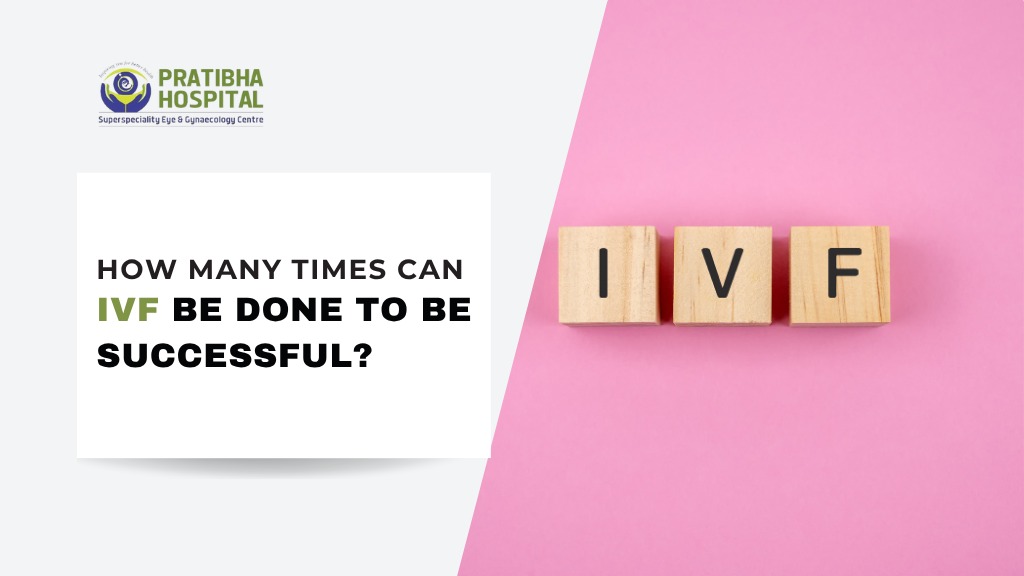How Many Times Can IVF Be Done To Be Successful?
For those facing challenges in having a baby, IVF brings a real possibility. But a common question that often comes up is, how many times can IVF be done? And more importantly, how many attempts does it take actually to succeed?

If you’re wondering about this, you’re not alone. IVF can feel overwhelming, especially when it doesn’t work on the first try. So, let’s talk through it in simple terms to understand how many IVF cycles people usually go through, what factors affect success, and what to expect along the way.
What Is IVF In Simple Words?
First, a quick recap. IVF helps by fertilizing the egg and sperm outside the body, under medical care. After fertilization, the lab-created embryos are carefully transferred into the womb, hoping they develop into a successful pregnancy.
Think of it like baking cookies: the eggs and sperm are ingredients, the lab is the oven, and the uterus is the plate where the cookies are placed to be enjoyed. Sometimes, the first batch doesn’t turn out right, so you try again.
Why Does IVF Sometimes Need More Than One Attempt?
It’s common for IVF not to succeed on the first go. There are many reasons why it might not work the first time:
- The embryo may not implant properly.
- The quality of eggs or sperm may vary.
- Sometimes, the environment in the uterus might not be ideal for pregnancy to begin.
- Other health factors can play a role.
So, it’s very common for couples to need more than one IVF cycle to get pregnant. That’s when the question of how many IVF cycles are possible really comes up.
How Many Times Can IVF Be Done?
There is no fixed number that applies to everyone, but here are some general points to keep in mind:
1. Medical Safety Limits
Doctors usually recommend trying about 3 to 6 IVF cycles before considering other options. This is because success rates tend to be higher in the first few attempts. Also, repeating the procedure many times can be emotionally, physically, and financially draining.
2. Age and Health Matter
Younger women often have higher success rates, so they may need fewer cycles. For women over 35 or with certain health issues, doctors might suggest fewer cycles and alternative treatments after some attempts.
3. Emotional and Financial Readiness
IVF is not just a medical journey—it’s an emotional and financial one too. Many couples decide to stop after a certain number of attempts because the stress and cost become too much.
Realistic Success Rates Per IVF Cycle
To help understand how many times IVF can be done realistically, let’s look at success chances per cycle:
- For women under 35, the chance of success per IVF cycle is about 40%.
- For women between 35 and 40, it drops to around 25-30%.
- For women over 40, it can be less than 10-15%.
This means that even if IVF doesn’t work the first time, chances improve a bit with multiple tries, but it’s not guaranteed.
When Should You Stop Trying IVF?
This is a deeply personal decision. Many doctors suggest evaluating after 3 to 6 unsuccessful cycles whether to continue or explore other options like egg donation or adoption.
Here’s a simple way to think about it:
Imagine trying to fill a jar with water using a small cup. Each scoop adds a little, but after several scoops, you start wondering if there’s a better way to fill the jar faster. After a number of IVF rounds, questioning whether to continue or change course is normal.
What Can Improve Your Chances?
While knowing how many times IVF can be done is important, improving the success rate with each attempt is also key. Here are some things that help:
- Healthy lifestyle: Supporting your wellness by choosing healthy foods and avoiding harmful habits like smoking and drinking.
- Managing stress: meditation, counseling, or simply talking with loved ones.
- Good medical care: choosing a trusted fertility clinic and following the doctor’s advice.
- Tracking cycles carefully: Sometimes doctors adjust medications or timing based on past cycles.
What Happens After Each IVF Attempt?
The wait to see if you’re pregnant after IVF can be the toughest part of the journey. If the cycle fails, doctors usually review what might have gone wrong and make adjustments for the next attempt.
This could be changing medication doses, trying different egg retrieval techniques, or checking the uterine lining closely.
Can IVF Be Done Many Times?
In theory, IVF can be repeated as many times as needed, but practically it’s limited by physical, emotional, and financial factors.

Some women have gone through 8 or more IVF cycles, but it’s rare. Most couples find success or decide on other paths before that.
Emotional Side of Multiple IVF Cycles
The question of how many times IVF can be done isn’t just medical—it’s emotional too.
Each failed cycle can bring disappointment and sadness. A strong circle of emotional and professional support brings comfort through the process. Some fertility centers have experts who talk with couples to ease their worries.
When IVF Works: The Joy of Success
After going through multiple cycles, when IVF finally works, it feels like a huge victory. That makes all the ups and downs worth it for many couples.
Summary: How Many Times Can IVF Be Done?
- There’s no strict limit, but usually 3 to 6 cycles are recommended.
- Success rates vary by age and health.
- Emotional and financial well-being matter a lot in deciding how many attempts to make.
- Each attempt helps doctors learn and adjust for better chances next time.
- Communicate openly with your doctor about your specific fertility challenges.
Conclusion
Knowing how many times IVF can be done helps set realistic expectations and prepare emotionally for the journey ahead. It’s a strong method for conceiving a baby, but not an overnight solution. Patience, support, and good medical care are key.
In today’s time, the role of the latest technology in IVF truly makes a difference.
Remember, every couple’s story is different. Different approaches work for different people. Keep talking to your doctor and loved ones, and take one step at a time.







